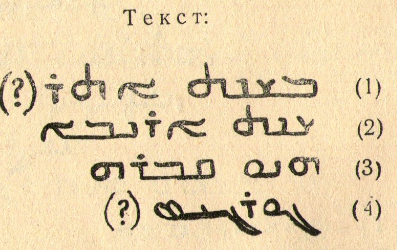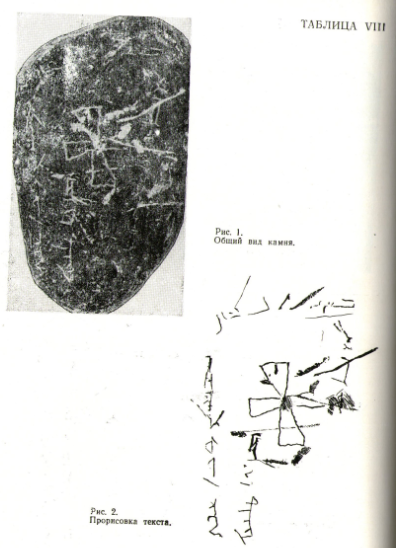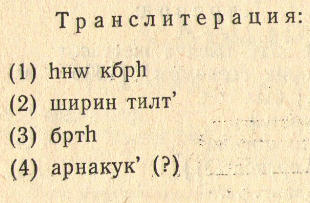Monuments from the vicinity of the village of Kara-Dzhigach
History teacher and local historian Y. N. Golendukhin found several stones with Nestorian inscriptions in the territory of the village of Kara-Dzhigach (now the Aala-Too state farm) in the Alamudun district. However, due to his unexpected death, the exact location of these stones remains unknown to us. All these monuments were entrusted to us for further research during Y. N. Golendukhin's lifetime. They consist of small stones and pebbles of various sizes without special processing. The inscriptions and crosses are carved with a sharp object, and the preservation of some of them is poor. It seems to us that the stones were found in the same fields where previous monuments were discovered; only these had remained under a thick layer of soil for some time and surfaced during plowing. Currently, these monuments are located at the Institute of Language and Literature of the Academy of Sciences of the Kyrgyz SSR.
Several stones with inscriptions have been collected in the school museum of the village of Kara-Dzhigach. According to local residents, many pebbles with inscriptions were extracted here during plowing and leveling in the 1940s and later, which were often used for various household needs and even exported beyond the territory.
The epitaphs published below from the vicinity of the village of Kara-Dzhigach enrich the rich collection of Semirechye monuments of early medieval Nestorianism, which had long-standing and strong traditions among the Turkic population.
MONUMENT NO. 1
A gray stone. The fourth line is damaged and is not fully restored yet. The drawing was made by us and is published without a photograph (table 1, fig. 1).

Translation:
(1) In the year of the rooster [there was].
(2) This is the grave
(3) of Pabrakim (?), a believing girl.
(4) ................

MONUMENT NO. 2
A dark blue river pebble of correct shape. The inscription is carved shallowly around the cross. It consists of short lines. The impression was taken by us in 1981. It is published for the first time (table 1, fig. 2, 3).


Translation:
(1) In the year 1603 [1282 AD]
(2) there was [the year]
(3) of the dragon.
(4) This
(5) is the grave
(6) of Tura-Kai (?) (maybe Turkushrak?),
(7) a believer.
(8) ...........

Note. The second component of the proper name (sixth line) is unclear. In the eighth line, the word has not been translated yet. We have not encountered it in published Syriac-Turkic texts.
MONUMENT NO. 3
A dark gray river granite elongated pebble. The inscription consists of four lines placed on three sides of an artistically crafted cross. The end of the second side line is damaged. The impression was taken by us in 1981. It is published for the first time (table II, fig. 1, 2).
Translation:
(1) In the year 1559 [1248 AD]
(2) This is the grave of B[ar],
(3) a priest (?),
(4) of a dear young man [. . .] [devoted]

Note. The name of the buried person could not be restored due to the damage to the text.
MONUMENT NO. 4
A dark gray river pebble of strong material. In the center of the stone, a cross is artistically carved, and around it, there is an inscription of five lines placed horizontally and vertically. The size of the stone is 49X29 cm. The impression was taken by us in 1981 (table II, fig. 3, 4).


Translation:
(1) In the year 1601 [1290 AD], this
(2) was [the year] of the hare.
(3) This is the grave of Georgis [Vargis],
(4) the abbot of the church,
(5) the son of the abbot of the church Antun [Anthony?].

Note. In the inscription in the first line, at the end of the second word, there is a sign

We have not encountered this sign in such a form in Y. Oiting's table or in other inscriptions. The text directly states that the deceased Georgis was the son of the abbot of the church Antun. In the text, the letter n is unusually long and resembles the letter l. Then this word could be read as Altun, but Altun is a Turkic female name. Therefore, it is possible that it refers not to Altun, but to Antun.
MONUMENT NO. 5
A smoky-colored pebble of correct shape, measuring 25X22 cm. The inscription consists of five lines, made in a carved manner. The impression was taken by us. It is published for the first time (table III, fig. 1, 2).



Translation:
(1) In the year 1600 (1289 AD) was (the year) of the bull.
(2) This is the grave
(3) of Mayfra (or Manfra) a believer,
(4) of a young girl,
(5) daughter of Gorgis,
(6) the commander.

Note. Of all the inscriptions presented here, this one has been preserved the best.
MONUMENT NO. 6
A gray flat pebble measuring 24X21X5 cm. The monument is heavily damaged, and the inscription is difficult to read (table III, fig. 3, 4).


Translation:
(1) In the year 1601 (1290 AD) [the year] of the tiger [was].
(2) This is the grave
(3) of Paliya (?) [a believer].

MONUMENT NO. 7
A smoky-colored stone measuring 22X18X7 cm. Of the four lines of the inscription, the last one is heavily damaged and is currently unreadable. The inscription was stamped by us. It is published for the first time (table IV, fig. 1, 2).


Translation:
(1) In the year 1601 [1290 AD]
(2) the year of the hare [was].
(3) This is the grave
(4) of Gorgis.

MONUMENT NO. 8
A dark blue stone of strong material, measuring 23X17X10 cm. The lower part is broken off. Four lines of inscription are carved around the decorative cross, the last word is not fully preserved. There are traces of blows and damage in many places. The impression was taken by us. It is published for the first time (table IV, fig. 3, 4).


Translation:
(1) In the year 1602
(2) [1301 AD] was the year of the bull.
(3) This is the grave
(4) of the young man Sufi.

MONUMENT NO. 9
A gray river stone of irregular shape. Its size is 26X14 cm. The stone has an inscription of four lines. A cross is carved in the center. It was stamped by us in 1981 (table V, fig. 1, 2).



Translation:
(1) In the year 1602
(2) [1301 AD] was the year of the bull.
(3) This
(4) is the grave of the girl Bichak.

MONUMENT NO. 10
A smoky-colored stone measuring 30X28X8 cm. Seven lines of inscription are placed around the decorative cross on four sides. There are chips at the bottom of the stone. The impression was taken by us. It is published for the first time (table V, fig. 3, 4).


Translation:
(1) In the year 1618
(2) [1307 AD] was the year of the ram,
(3) in Turkic — koy.
(4) This is the grave of Petros,
(5) a disciple, son
(6) of Yohanan,
(7) the archbishop (?).

MONUMENT NO. 11
A dark blue stone of strong material measuring 35X19 cm. There is a chip at the bottom. The inscription of six lines is carved on the uneven front side of the stone. The impression and photograph of the inscription were made by us in 1981 (table VI, fig. 1, 2).


Translation:
(1) In the year one thousand
(2) six hundred forty
(3) seven [1336 AD] was the year
(4) of the mouse...
(5) [This] is the grave of Kutlug-Tarim,
(6) a girl.

MONUMENT NO. 12
A gray stone measuring 27X22X14 cm, tapering downwards. Around the cross, there are five lines of inscription made in a carved manner. Some parts of the text are poorly visible. The impression was made by us. It is published for the first time (table VI, fig. 3, 4).


Translation:
(1) In the year one thousand six hundred
(2) forty-nine [1338 AD] ([there was]
(3) the year of the leopard.
(4) This is the grave of Sufi,
(5) a believer.

MONUMENT NO. 13
A gray pebble tapering downwards. Its size is 29X24X12 cm. The front side is heavily damaged. There are six lines of inscription. It was stamped by us. It is published for the first time (table VII, fig. 1, 2).


Translation:
(1) In the year one thousand six hundred forty
(2) nine [1338 AD] [the year]
(3) of the hare (?) [was].
(4) This is the grave
(5) of a believing girl
(6) Bichak (?).

MONUMENT NO. 14
A gray river pebble of correct shape measuring 36X27 cm. An inscription of five lines is carved, with a decorative cross in the central part. It was stamped by us in 1981 (table VII, fig. 3, 4).



Translation:
(1) In the year one thousand
(2) six hundred fifty [1339 AD] was
(3) the year of the hare.
(4) This is the grave
(5) of the believer Kytik (?).

MONUMENT NO. 15
A dark blue stone of correct shape, tapering at the bottom. Its size is 29 X 17X7 cm. Four lines of inscription are poorly preserved. The translation is tentative. The impression was taken by us. It is published for the first time (table VIII, fig. 1, 2).


Translation:
(1) In the year one thousand six hundred
(2) fifty [1339 AD] was the year
(3) of the dog (?). The girl
(4) ... [believer] (?)

MONUMENT NO. 16
A gray river stone with a greenish tint (granite). There are six lines of inscription around the cross, some of which are damaged. The size of the stone is 24X23X10 cm. There are chips in the lower right part. The photograph and impression were made by us. It is published for the first time (table VIII, fig. 3, 4).


Translation:
(1) In the year one thousand six hundred
(2) forty [seventh] [1336 AD] was the year
(3) of the chicken.
(4) This is the grave
(5) [of Gorgis (?)]
(6) .............

MONUMENT NO. 17
A gray stone with a pink tint measuring 24X24X90 cm. Four lines of the inscription are barely visible. The second and the beginning of the fourth lines, which are heavily damaged, have not yet been restored. The photograph and impression were made by us. It is published for the first time (table IX, fig. 1, 2).


Translation:
(1) In the year one thousand...
(2) This is the grave
(3) of Pachak (?) a believer

MONUMENT NO. 18
A gray-blue stone of irregular shape measuring 21X20x9 cm. Traces of four short lines are visible, carved around the sides of the cross in a carved manner and damaged in places. The impression was taken by us. It is published for the first time (table IX, fig. 3, 4).


Translation:
(1) This is the grave
(2) of the girl Shirin,
(3) the daughter
(4) of Arnakuk (?)

MONUMENT NO. 19
A dark smoky-colored river pebble, tapering downwards, measuring 30X25 cm. The two-line inscription is carved in a carved manner. In the middle of the stone is a cross. The impression was taken by us in 1981. It is published for the first time (table X, fig. 1, 2).


Translation:
(1) This is the grave
(2) of Tura-Puki.

MONUMENT NO. 20
A gray pebble of correct shape. Its size is 35X25 cm. The poorly preserved inscription consists of two short lines. It is located on the right part of the cross. The drawing was made by us in 1980. It is published for the first time (table X, fig. 3, 4).


(1) Ilbilge ku —
(2) tich(?)

Note. Only the name of the deceased is written — Ilbilga... However, the correctness of reading the second part of this complex name is questionable. In any case, we encounter such a combination for the first time.
MONUMENT NO. 21
A dark pink flat pebble made of granite, tapering downwards. Its size is 25X17X6 cm. The front part is so damaged that the inscription is completely unreadable. The cross has been preserved more or less satisfactorily. It was photographed and stamped by us. It is published for the first time (table XI, fig. 1, 2).

MONUMENT NO. 22
A white-speckled strong sandstone measuring 18X18X4 cm. A cross is clearly and artistically carved. On both sides of the cross, there are two short lines of inscription. The second is poorly visible. The impression was taken by us. It is published for the first time (table XI, fig. 3, 4).


Translation:
(1) This is the grave
(2) ...........

MONUMENT NO. 23
A dark gray pebble measuring 22x14x5 cm. In its central part on the front side, a cross is carved, without inscriptions. There are chips along the entire length on the right side. There are also chips on the back side, in the left part. The drawing was made by us. It is published for the first time (table XII, fig. 1, 2).

MONUMENT NO. 24
A blue strong river pebble measuring 20X18X5 cm. A cross is carved on the front side at the upper part. There are no inscriptions. It was photographed and stamped by us. It is published for the first time (table XII, fig. 3, 4).




